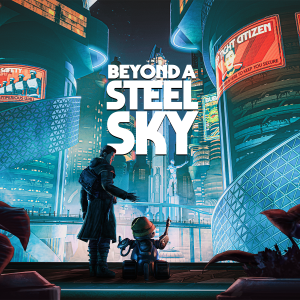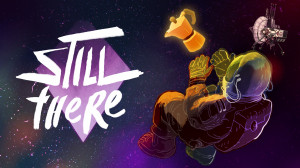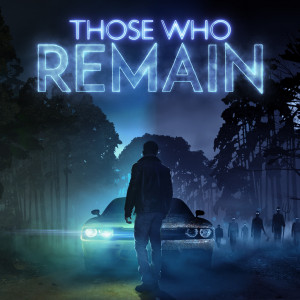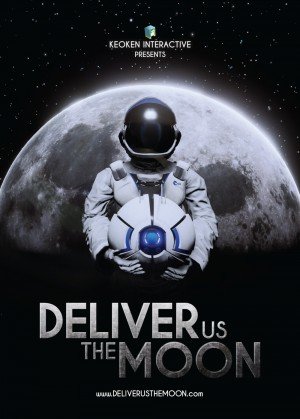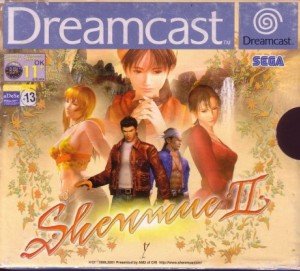Gamescom 2019 round-up: Part 1

Traditional point-and-clicks, comic book adaptations, VR voyages deep into the uncharted desert of the Internet’s lost data… For a fan of adventure titles, the tenth edition of the “world’s largest gaming event” certainly didn’t disappoint. Gamescom may not be the industry’s splashiest show compared to the likes of E3 (Keanu Reeves was sadly absent, at least in person, from Cyberpunk 2077’s demo) but the 120-game-strong Indie Booth alone proved that it’s still a huge draw for developers and gamers wanting to promote or play something a little bit different.
From the return to a classic adventure game universe like Revolution’s Beyond a Steel Sky to more contemporary titles playing around with the conventional ideas of narrative such as Mad About Pandas’ Hitchhiker or GhostShark’s Still There, I was positively overwhelmed by the huge variation of story-driven games on offer. I dutifully played through as many as I could (isn’t life hard?) at the week-long event in Cologne’s gigantic Koelnmesse exhibition centre, and came back with lots of insights to share about where the genre will be taking us into next year and beyond – along with many, many free stickers and key rings.
The annual Adventure-Treff party, held by our German counterparts in the aftermath of the frenzied high of gamescom, offered up another chance to play some of the most exciting narrative games coming to us in the next few months in a more relaxed setting. I’ll be delving into all of my experiences over three separate articles, but I was particularly impressed by the pleasing puzzles of Tag of Joy’s European mystery adventure Crowns and Pawns, and the quirky dark humour of CMMN CLRS’ game set in the Land of the Dead, PRIM.
So whilst the rest of the gaming media hypes up the urination mechanics (yes, really) of Hideo Kojima’s Death Stranding, here’s the first of several in-depth looks at the adventure games on display at gamescom 2019. I’d say we definitely got the better deal.
Beyond a Steel Sky
Robert Foster returns, ten years on from the events of the sci-fi point-and-click classic Beneath a Steel Sky, back to a place he never wanted to return to: Union City. Revolution’s CEO, co-founder and all round adventure gaming royalty Charles Cecil was on hand to show how they’ve reimagined Foster and his old digs 25 years after releasing the original game. Gone is the 2D art; instead Beyond a Steel Sky uses a cel-shaded 3D approach. However, fans of the first game will be glad to know the sequel will once again feature the stylings of award-winning Watchmen comic book artist Dave Gibbons to get that graphic novel feel.
 |
Laura flanked by Revolution's Tobias Fossheim (L) and Charles Cecil |
I was shown around the outskirts of Union City as Foster tried to figure out a way back into the place he swore he’d never revisit. You won’t need to have any knowledge of previous events to play Beyond (though why you wouldn’t want to play the classic is certainly beyond me, especially as it’s free) but some locations and characters from the original will return. Cecil revealed tantalizing details of why Foster has made the journey from the desolate outskirts of the Gap back to Union City: a child has been stolen, and our protagonist is back to dig deeper into the disappearance – and no doubt discover other disturbing goings-on along the way. We’ll also see a return of Foster’s smart-ass robot companion Joey and his replaceable shells with different functions.
The idea of Virtual Theatre, which Revolution pioneered in the ‘90s, is back too. It’s a simple concept on paper: every character in the game moves around with their own motivations, instead of being stuck to one spot, there just to respond to player. Of course, to progress further you’ll have to manipulate those motivations, either through dialogue choices, inventory items or even hacking machines. The hacking puzzles in particular look like they’ll be an exciting aspect of the sequel. Once Foster gets the ability, he’ll be able to bring up a hacking screen for machines and “swap around” the logic to get different outcomes.
As an example in the demo, bringing up the hacking skill on a vending machine gives you the option of being able to switch the “sound alarm if tampered with” and “give drink to citizens with correct ID” results by clicking on them, so that now tampering with the machine gets you a drink, whilst any poor citizen that wants a drink will simply get an alarm sounding in their ear. Whilst this is an early, fairly simple example, the logic will apparently get more complicated as the game goes on, giving a lot of free rein for creative thinking.
The open-ended approach all lends a sandbox-style feel to solving puzzles where there may be one issue but many solutions. It’s also going to be possible to die in the game, because, as Charles explains, they want to give the player “a sense of jeopardy,” though always with enough time to hopefully work one’s way out of it. There won’t be any QTEs à la Broken Sword: The Sleeping Dragon.
For now I bid an intrigued farewell to Union City, or at least its surroundings, excited to return to the comic book dystopia for its fourth quarter release on PC and Apple devices.
Still There
 |
GhostShark's Domenico Barbieri and Demigiant's Daniele Giardini |
“Papers Please in space” doesn’t really do proper justice to Still There, a game which sees you managing the day-to-day menial tasks of running a space station whilst coping with the loss of your daughter. It’s a phrase the developers use more to describe the mechanics rather than the story, as just like in Lucas Pope’s hit, players will have to go through a daily routine of various activities to earn money and proceed to the next schedule-filled day – except here it’s aboard the Bento spaceship rather than at immigration border control. Also in a similar vein to Papers Please, the real narrative and emotional core is hidden beneath these repetitive tasks and slowly peeled back as you progress, in this case telling the story of how one person copes with depression.
As well as life aboard the ship, the game is mixed up with dream sequences featuring a disembodied voice talking to our depressed spaceman Karl about life and his current mood. In the demo I got to see a small glimpse of how our protagonist’s despair can affect gameplay itself: although you’re given two options to seemingly choose from when asked if you’re all right, Karl’s denial means that you’re only able to physically click the “I’m okay” option. It’s a nice feature that the developers say will be integrated further as things get harder for Karl to carry on.
Although the game deals with a heavy topic, there’s a lightness to some of the interactions on the ship, particularly with the fed-up onboard AI. There will also be technical and logical puzzles (e.g. pressing buttons in the right order until they all light up) within the tasks that Karl has to finish, though the developers tell me there will be an easier puzzle option available for those who just want to get on with the whole business of feeling lonely up in space.
TOHU
This traditional point-and-click adventure game marries the beautifully detailed 2D graphic style of Machinarium with the puzzle mechanic of being able to turn from girl to robot at whim. In TOHU you play this young child as she travels through a beautifully hand-drawn world of fish-planets (naturally!) on a quest to find someone who can help mend the Sacred Engine, the machine that keeps said piscatorial planets running – which, unfortunately for everyone, has broken down.
Most of the puzzles I saw in the demo revolved around switching between the girl and her larger, stronger robotic alter-ego, a Cubus, but there was also some fun to be had at one point in flinging rocks across the forest to knock four buzzing wasps in order to get them to help me fly my spaceship. The landscapes are alive with little details to check out, from crawling creatures to squish to dangling lights to jangle. Much like another of Amanita Design’s more recent titles, CHUCHEL, the humour is charmingly slapstick here, and the quirky atmosphere will be completed with a score by Hollow Knight’s Christopher Larkin.
In a time of too much doom and gloom all around us, this chirpy, charming adventure can’t come soon enough – expect to see TOHU next summer across all platforms.
The Almost Gone
 |
Happy Volcano's Jeroen Janssen |
Squeeze the isometric design of Monument Valley into a darker, more mature story and you’ll get Happy Volcano’s The Almost Gone. Whilst the colour scheme is all light pastel shading, the story of a young girl trapped between life and death trying to figure out why she’s died leans more towards the blacker side of things.
The game is split into five acts and each focuses on a certain location, such as your old house or a police station, cut out and presented like a diorama to swivel through each room with a click or swipe of the mouse. You must scour each room for objects that will help you progress further, turning music boxes to reveal secret notes and digging up gardens for bone-shaped puzzle fragments whilst little pieces of the story filter through your discoveries. At present the narrative thread feels a little lost inside the gorgeous locations and every little intricate object inside them, but when all five acts come together these elements should become clearer.
The Almost Gone’s tactile swiveling and tapping and short pick-up-and-play levels will fit particularly well with mobiles and Nintendo Switch, for which it is being designed to release alongside desktop PCs hopefully sometime later this year.
Paper Beast
Forget exploring alien planets and instead take a leap deep into the lost algorithms and forgotten code of a data server, imagined in this VR game for the PlayStation by Eric Chahi, the acclaimed creator of platforming action-adventure Another World (or Out of This World for you US residents). Paper Beast is thankfully not a nightmare of wires or bleeping servers, though, but a sprawling, near-desolate Journey-like desert, peppered with a unique and fully simulated ecosystem to discover and interact with.
In this digital world, all of the creatures I encountered looked like origami creations, no doubt a poetic take on big data. During my demo I quickly found myself journeying across the sands with a hulking beast of Brontosaurus proportions, pulling sticky strings of black gloop from its legs (seemingly a Chahi staple from Heart of Darkness times) to help it as it strode across the plains and through puddles. You move, or rather teleport, across short spaces with a tap of the left controller whilst the right is mainly assigned for grabbing and letting go of objects or creatures.
With a playful flick of the right stick, I played catch with a scrunched-up ball and two frisky little paper beasts. Later on I pushed through a sandstorm of numbers flying into my face, the wind howling around my head as I sought shelter. Eric explained that some of the beasts such as our big pal will be friendly and help you, but others might not be so inclined to welcome a stranger into their world.
Whether the game can build on its intriguing concept and create a compelling narrative alongside its wildlife sandbox remains to be seen, but Chahi’s involvement at the very least means we’re in for a surreal ride. We’ll find out more soon enough as Paper Beasts will be stomping onto PlayStation VR in the second quarter of 2020.
Those Who Remain
 |
Camel 101's Ricardo Cesteiro |
Whatever you do, don’t go into the dark. That seems to be the resounding rule for many horror titles throughout gaming history, and you can now add the psychological thriller Those Who Remain to that spooky list. You see, weird things start happening when the main character Edward tries to go into the dark as he makes his way through the sleepy (read – creepy) town of Dormont. Unfortunately, what mostly happens is that silent zombie-like creatures with glowing eyes turn up and rip him a new one.
Ever the optimist, Edward needs to find light to make his way through the abandoned buildings and find out why everyone’s face is lighting up like a Christmas tree. In the demo this made up the majority of the puzzles on show, whether it was simply finding a light switch to flick on and make the ghouls instantly disappear, or more intriguingly by transporting into an alternate reality to make things happen there that you can’t in the normal version. For example, a car feels like it’s bound by something but there’s no apparent object blocking it. Slip into alterno-land (not what the developers are calling it), and suddenly you can see it’s wrapped up in vines, which you can now easily cut.
You can learn more about why Edward is suddenly able to cross dimensions at will when Those Who Remain comes out for PC, PS4, Xbox One and Switch in December.
The Wanderer: Frankenstein’s Creature
Taking control of Frankenstein’s monster may sound like a recipe for chaos and violence, but in The Wanderer La Belle Games offers an interpretation much closer to the philosophical reflections of Mary Shelley’s original novel. Play begins with the monster’s creation as you control the beast himself – just a few black paint strokes hunched under a hooded white robe. In keeping with the Romantic era theme, all 18 backgrounds you come across as the creature have been beautifully hand-painted in the style of watercolours of that time. As you progress, your journey split up into chapters, you will become more aware of your hideous form, forced to choose whether to retaliate or roar at jeering adults. I was told these choices will appear throughout the game and affect the creature’s evolution, with the visuals and music changing dynamically according to his mood – fearful, angry, sad, etc.
You can find out what it takes to be (or become) human when the game is released this autumn on Windows, Mac and mobile devices, with a Switch release also likely later on.
Deliver Us the Moon
 |
KeokeN's Paul Deetman |
Whilst the bulk of KeokeN’s sci-fi thriller set in a near-apocalyptic future has already been out for close to a year now, there’s still one small step left before the story reaches completion. Those who read our review of the game will remember that the edition released at launch ended with an abrupt “to be continued” and the promise that everything would be resolved by free DLC in 2019. Whilst I wasn’t able to get my hands on the concluding instalment at gamescom, the Dutch developer claimed that the final chapter will pick up directly from where the story left off, as players continue their quest as a lone astronaut sent to the moon on a mission to save humanity. As well as a final tying together of the narrative, there will be plenty more challenges, including environmental hazards such as electricity, heat and water.
Along with the completion of Deliver Us the Moon on PC with the free update, the full game will also be released in 2020 for the PS4, Xbox One and Switch.
The White Door
Fans of the Cube Escape and Rusty Lake series will already be aware of their indie developer’s dark and occasionally quite macabre brand of humour, which doesn’t let up in their latest adventure. The White Door follows seven days in the life of protagonist Robert Hill in a mental health facility, trying to work out exactly what’s put him there in the first place. In a break from the team’s previous titles, this game uses a split-screen interface for interaction. For example, I got Robert to brush his teeth and the screen split between a close-up of his dazed face in the mirror and a bird’s eye view of his room, much like two comic book panels. I then had to swipe the screen back and forth on the tablet to simulate brushing.
In between solving various logic puzzles, this kind of tapping and dragging on the screen should feel very intuitive when The White Door is released on mobile devices later this year, along with a PC version on Steam and itch.io.




